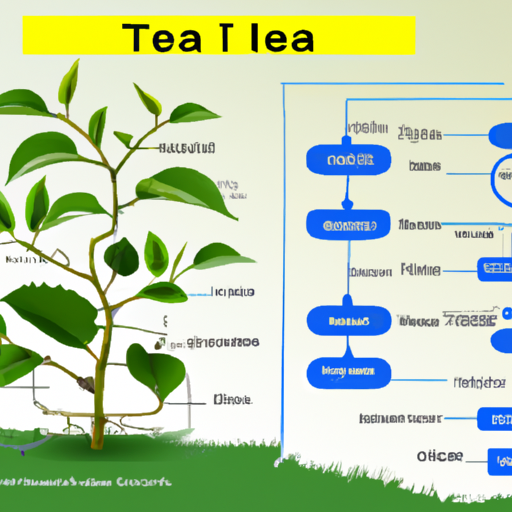Tea Botany 101: Understanding the Life of a Tea Plant
Pour yourself a cuppa and buckle up, because today we're diving deep into the world of tea botany! This leaf-turned-liquid journey takes us to the life of the tea plant, Camellia sinensis. It's no secret that all tea types originate from this magical little plant. But have you ever wondered about the growth, development, and fascinating features of this botanical wonder? We'll examine the tea plant's life stages, its unique characteristics, and the role climate plays in shaping the diverse flavors we know and love. So sip along as we steep ourselves in botanical knowledge. Leaf your thoughts and brewing questions in the discussion area below – we'd love to hear them!
Life Stages of a Tea Plant
The tea plant's life can be divided into three main stages: the seedling stage, the growth and maturation phase, and the production stage. Let's explore them, shall we?
1. Seedling Stage: Tea plants begin their lives as seeds, typically obtained from the ripe fruit of a healthy, mature plant. Mature seeds resemble small, hard shiny beans that germinate within a few weeks. The germination process, where the seed sprouts and starts to grow, can be affected by factors such as humidity, temperature, and soil quality. Once germination occurs, seedlings emerge, and the future tea plant starts its journey to greatness.
| Stage | Duration | Key Features |
|---|---|---|
| Seed Germination | 2-5 Weeks | • Humidity/temperature-sensitive• Small, hard seeds |
| Seedling | 1-2 Years | • Grows to knee height• Development of first true leaves |
2. Growth and Maturation Phase: The seedlings grow at lightning speed during the initial years, gaining height to become young tea plants. It's during this stage that the plant develops its first true leaves, making significant strides in leaf production capacity. Tea plants can reach heights of 30 to 50 feet if left to grow wildly, but they're generally pruned to allow easy harvesting.
| Stage | Duration | Key Features |
|---|---|---|
| Growth and Maturation | 2-4 Years | • Pruned for easier harvesting• Significant strides in leaf production capacity |
3. Production Stage: Upon reaching maturity (usually between years 4 and 5), the tea plant is ready to officially enter the production stage. It's during this phase that the coveted young leaves are harvested for tea production, with the plant undergoing periodic pruning for improved growth and yield. A well-maintained tea plant can produce quality leaves for 50-100 years!
| Stage | Duration | Key Features |
|---|---|---|
| Production Stage | 50-100 Years | • Young leaves harvested• Periodic pruning for improved growth |
Unique Characteristics of the Tea Plant
The Camellia sinensis plant flaunts some intriguing characteristics that make it a one-of-a-kind botanical gem:
- All Tea Types, One Plant: Despite the riot of flavors, aromas, and colors, all true teas (white, green, oolong, black, and pu-erh) come from the same plant. The tea type variation is due to the cultivation and processing methods used after harvesting.
- The Medical Marvel: Tea leaves contain diverse chemicals and compounds, many of which boast health benefits. Polyphenols, catechins, and theanine are just a few of the bioactive compounds that have put the tea plant in the good graces of medical research.
- Camellia Cousins: Although the tea plant is the most famous member of the Camellia family, it shares its botanical heritage with over 200 other Camellia species, known for their ornamental beauty.
Climate's Role in Tea Flavor Profile Development
The regional peculiarities – including climate, topography, and soil composition – create the unique terroir that imbues each tea variant with its signature flavor. Some prime examples include:
- Altitude: Higher altitudes mean lower temperatures, which results in slower leaf growth, concentrating aroma and flavor. For instance, Darjeeling tea, grown at high altitudes in India, has a delicate, refined flavor profile.
- Temperature and Humidity: The climate during tea leaf growth affects the leaf composition. Warmer temperatures can promote the development of essential oils, impacting the final flavor. The temperature changes of Chinese Tie Guan Yin can help infuse the tea with creamy and fruity notes.
- Rainfall and Water Availability: Tea plants require abundant water, and rainfall plays a significant role in determining growth and quality. Inconsistent or excessive rainfall can lead to unpredictable flavor profiles or weaker tea plants.
In Conclusion: Steeped in Knowledge
Ultimately, appreciating the life journey of the tea plant – from seed to steaming cup – enriches our tea-drinking experience. Understanding the various life stages, unique characteristics, and climate's influence on the tea plant endows us with a newfound respect for this precious brew. As we sip our favorite teas, let's take a moment to marvel at the magic of the Camellia sinensis plant – the botanical enigma that warms our hearts (and teacups) across borders, cultures, and generations.
So brew yourself to all this fascinating tea botany, and don't hesitate to chime in with comments, questions, or a tasteful pun. The tea plant's life may not be everyone's cup of tea, but it offers a splendid backdrop to understand and appreciate this versatile and time-honored drink. We hope you enjoyed this botanical brew-haha, and, as always, happy sipping!
